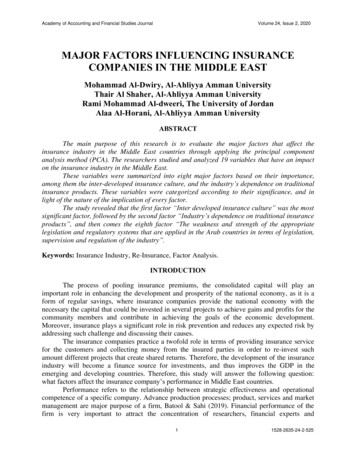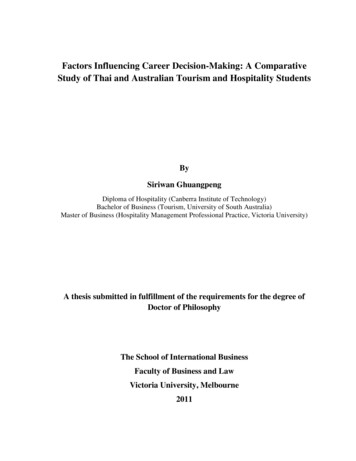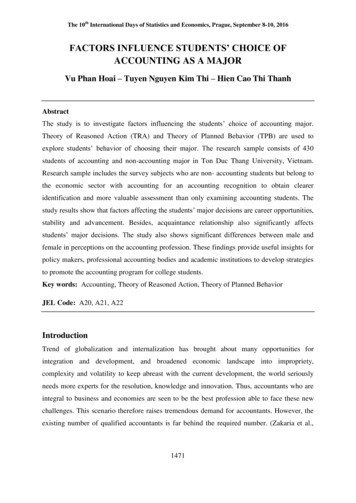
Transcription
Academy of Accounting and Financial Studies JournalVolume 24, Issue 2, 2020MAJOR FACTORS INFLUENCING INSURANCECOMPANIES IN THE MIDDLE EASTMohammad Al-Dwiry, Al-Ahliyya Amman UniversityThair Al Shaher, Al-Ahliyya Amman UniversityRami Mohammad Al-dweeri, The University of JordanAlaa Al-Horani, Al-Ahliyya Amman UniversityABSTRACTThe main purpose of this research is to evaluate the major factors that affect theinsurance industry in the Middle East countries through applying the principal componentanalysis method (PCA). The researchers studied and analyzed 19 variables that have an impacton the insurance industry in the Middle East.These variables were summarized into eight major factors based on their importance,among them the inter-developed insurance culture, and the industry’s dependence on traditionalinsurance products. These variables were categorized according to their significance, and inlight of the nature of the implication of every factor.The study revealed that the first factor “Inter developed insurance culture” was the mostsignificant factor, followed by the second factor “Industry’s dependence on traditional insuranceproducts”, and then comes the eighth factor “The weakness and strength of the appropriatelegislation and regulatory systems that are applied in the Arab countries in terms of legislation,supervision and regulation of the industry”.Keywords: Insurance Industry, Re-Insurance, Factor Analysis.INTRODUCTIONThe process of pooling insurance premiums, the consolidated capital will play animportant role in enhancing the development and prosperity of the national economy, as it is aform of regular savings, where insurance companies provide the national economy with thenecessary the capital that could be invested in several projects to achieve gains and profits for thecommunity members and contribute in achieving the goals of the economic development.Moreover, insurance plays a significant role in risk prevention and reduces any expected risk byaddressing such challenge and discussing their causes.The insurance companies practice a twofold role in terms of providing insurance servicefor the customers and collecting money from the insured parties in order to re-invest suchamount different projects that create shared returns. Therefore, the development of the insuranceindustry will become a finance source for investments, and thus improves the GDP in theemerging and developing countries. Therefore, this study will answer the following question:what factors affect the insurance company’s performance in Middle East countries.Performance refers to the relationship between strategic effectiveness and operationalcompetence of a specific company. Advance production processes; product, services and marketmanagement are major purpose of a firm, Batool & Sahi (2019). Financial performance of thefirm is very important to attract the concentration of researchers, financial experts and11528-2635-24-2-525
Academy of Accounting and Financial Studies JournalVolume 24, Issue 2, 2020management of other corporations. It is such a difficult task to select a successful company, thatwhy they have to be concern with the profitability of the firm. According to Doumpos, et al(2012). The financial performance of insurance industry is very important to variousstakeholders including agents, policyholders, and policy makers.Previous Research/Former literatureA study was conducted by Mwangi et al. (2015) to identify the factors that affect theprofitability of general insurers in Kenya. The study used multiple linear regressions, with returnon assets as the dependent variable, and the study was made for all the general insurancecompanies in Kenya for the period 2009-2012. Profitability was positively related to influence,equity capital, and management competence index and negatively related to the size andownership structure. The study did not find a relationship between performance and retentionratio, liquidity, underwriting risk and age. The study recommended that general insurers inKenya should improve their performance by increasing leverage, equity capital and the qualityand competency of their staff.Zhara et al. (2014) applied structured questionnaires to explore the extent of theapplication of risk management in insurance companies in Kosovo and its impact on theirbusiness performance. Furthermore, the annual reports of the insurance companies are used toevaluate their financial performance.The hypothesis of this study relates to the impact of risk management in the financialperformance of the companies participating in the study. We can say that the informationprovided may show the situation of the sector and the practices of the insurance market inKosovo in terms of risk management policies and their influence on modern risk management inthe company's financial performance in the insurance market of Kosovo. Hence, these data canbe of great interest to any other local companies to prompt them to put risk management at thetop of their agenda knowing that insurance companies in this area remain behind developedcompanies in the region and the EU.Burca et al. (2014) tried to analyze the determinants of the financial performance in theRomanian insurance market during the period 2008–2012. According to the final resultsachieved by applying specific panel data techniques, the determinants of the financialperformance in the Romanian insurance market were the financial leverage in insurance,company size, growth of gross written premiums, underwriting risk, risk retention ratio andsolvency margin.Merhari et al. (2013) investigated the impact of firm level characteristics (size, leverage,tangibility, Loss ratio (risk), and growth in writing premium, liquidity and age) on theperformance of insurance companies in Ethiopia. Return on total assets (ROA) a key indicator ofinsurance company's performance- was used as dependent variable while the age and the size ofthe company, growth in writing premium, liquidity, leverage and loss ratio were independentvariables. The sample included 9 insurance companies over the period 2005-2010. The auditedannual reports (Balance sheet and Profit/Loss account) of insurance companies were obtainedfrom the National Bank of Ethiopia (NBE) and the insurance companies’ annual publicationreports. The results of regression analysis reveal that insurers’ size, tangibility and leverage arestatistically significant and positively related with return on total asset; however, loss ratio (risk)was statistically significant and negatively related with ROA. Thus, the insurers’ size, loss ratio(risk), tangibility and leverage were important determinants of the performance of insurance21528-2635-24-2-525
Academy of Accounting and Financial Studies JournalVolume 24, Issue 2, 2020companies in Ethiopia. But, growth in writing premium, insurers’ age and liquidity hadstatistically insignificant relationship with ROA.Almajali et al. (2012) aimed to investigate the factors that mostly affect financialperformance of the Jordanian Insurance Companies. The study population consisted of allinsurance companies enlisted at Amman Stock Exchange during the period (2002-2007) whichwere (25) insurance companies. The data collected was analyzed by using a number of basicstatistical techniques such as T-test and Multiple- regression. The results showed that thefollowing variables (Leverage, liquidity, Size, Management competence index) had a positivestatistical effect on the financial performance of Jordanian Insurance Companies. The researcherrecommended that a high consideration of increasing the company assets will lead to a goodfinancial performance and there was a significant need to have highly qualified employees in thetop managerial staff.Moghadam et al. (2012) compared the performance of different insurance companies inIran in 9-month period of 2011, because in this competitive environment comparing theperformance of the insurance companies and identifying competitive advantages and detectingthe best competitors is the most important necessary action to promote the sector of the insurancecompanies. The findings of this study were as follows: Iran and Asia and Alborz insurance hadthe most premium manufacturing and insurance companies of Dey & Mihan which had anoticeable growth in the same period of the previous year.Al shaher et al. (2011) concentrates on evaluating the major factors that affect thecommercial banks performance in Middle East region based on factors analysis technique. Theauthors have chosen 23 variables and analyzed them according to factor analysis techniques(PCA).The results revealed that the first factor (banks characteristics) is considered the mostimportant factor to banks performance. On the contrary, the sixth factor (religion believes andawareness of banks performance) is considered the least important factor that influencescommercial banks performance in Middle East region. The research results suggest thatcommercial banks in Middle East region should concentrate on the religion beliefs andawareness of banks' performance.Iswati et al. (2007) used the empirical data from Indonesia Capital Market Directory 2005that was issued by Jakarta Stock Exchange (JSE). This research used the quantitative analysisapproach. The population of the research consisted of the insurance companies at listed in JSE.The hypothesis test conducted through the regression analysis model with the degree ofsignificance at 0.05. The main conclusion from this particular study was intellectual capitalwhich had influence on the banks’ performance.METHODOLOGYGenerally speaking, the researchers focused on the assessment of the insurancecompanies’ performance by examining their financial ratios and indicators, because thesecompanies are financial institutions aiming to achieve financial returns to maintain acceptablefinancial level such as; returns on investment (ROI), return on equity (ROE) and other indicatorswhich depend on evaluating the financial performance. However, in this study, the researcherexamined the factors affecting the performance of insurance companies by relying on the factoranalysis approach, which involved the analysis of individual trends towards the questionnairestatements.31528-2635-24-2-525
Academy of Accounting and Financial Studies JournalVolume 24, Issue 2, 2020The variables according to this approach can be classified to the rank either ascending ordescending order according to their importance from multiple options (Al Shaher, 2011).Also, factor analysis sums up a wide range of variables to a smaller number of unrelated factorswith every variable, and explain each factor as a set of variables that are related to a particularproperty.Component Analysis Method was adopted as a method of the factor analysis whichconsisted of the following stages (Norusis, 1993).Presentation of the answers of the questionnaire in the form of a matrix to represent therespondents, while the columns to represent the study variables.Correlation matrix between the variables was considered a data matrix.The association matrix between the variables was analyzed to determine the lowestnumber of groups of factors that can be changed by the variance between variables. The resultswere extracted in matrix factors, where the ranks of matrix represented the study variables andcolumns represented a number of factors that included these variables.In order to explain the matrix of factors, the first factor was considered the mostimportant because it occupied the largest proportion of the total variation, and it consisted themost important variables of the study, while the second factor followed the first factor in termsof importance, and its variables were in the second rank according to their importance, and so onfor the other variables.The data was collected by designing questionnaire as the study tool, with two parts; thefirst part was developed to collect the demographic data from the sample members, while thesecond part included questions on 19 variables which affect the performance of the insurancecompanies.Population and SamplingAccording to a report provided by Amman Stock Exchange (2019) there are 21 insurancecompanies listed. As a result of the similarity of the insurance industry in these companies, arandom sample was collected for 15 companies and the questionnaire was distributed to 300employees for the upper and middle levels.Study TechniquesIn this study, the questionnaire was relied upon to analyze the directions of a group ofinsurance industry specialists. The items in the questionnaire were compatible with the studyobjectives, as it consisted of 19 questions distributed on the randomly selected sample in order toobtain critical results for the subject of the study.To measure the estimates of respondents, it was requested to specify the importance ofthe question from the most important to the least important, that is, the most important questiontakes weight 19, and the least important of them takes the weight 1Validity and reliability of the ToolTo measure the strength of reliability between the variables the Cronbach alpha was used.To add, a significant note that values between 0 and 1, and the closer the value to 1, the more it’sconsidered reliable and when it is closer to 0, the more it’s considered less reliable Cronbach,41528-2635-24-2-525
Academy of Accounting and Financial Studies JournalVolume 24, Issue 2, 2020(1951). From the table below the minimum value for the reliability coefficient Cronbach’s alphais 0.611 which is acceptable value to 0.915 which is a high value.Table 1CRONBACH ALPHAVariablesItems12345678910111213141516171819X1 Weakness of the capital of the insurance companies, and the lack of strong financialentities.X2 Marginal and weak insurance entities, which led to concluding mergers with anotherbanking institution.X3 Higher premiums reinsurance installments, due to lower retention rates as a result ofthe weak capital.X4 Insurance did not play its role as a financing source for investments in the MiddleEast as the case was in Europe.X5 Fragility in the relative importance of the insurance industry in the economies of theArab countries, as the percentage of the insurance premiums is 8% of GPD.X6 Insurance companies still rely on traditional insurance products, and did not improvetheir products.X7 Lack of interest of insurance companies in customers’ needs and attitudes, customersatisfaction, and service integration which represent the most important marketingconcepts.X8 Diminutive attention to the development of life and personal insurance, whichrepresents 60% of the volume of insurance premiums in the world.X9 Lack of interest in raising insurance awareness, besides people’s awareness of theirinsurance rights.X10 Focusing only on price element and ignoring other issues etc.X11 Low per capita premiums that range from 8.1 in Algeria to 38 in Saudi Arabia.X12 Regressive style in work procedures in the insurance sector operations, in terms ofapplying manual or semi-manual operating approach with an inadequate informationsystem which reduces the size of benefits that have to be maintained from thetechnological development in the process of rationalizing the administrative decisionsand curtailing costs.X13 Weakness in using the technology in marketing the insurance products.X14 Lack of appropriate legislations and regulatory system in place in Arab countries interms of legislation, supervision and control of the insurance industry.X15 Weakness of administrative performance of high managerial levels in the insurancecompanies which affects the understanding of the nature of the risks and makes itdifficult to expect any possible crisis.X16 Poor communication level with others, and in human resource management which isessential to achieve the goals by enhancing the staff capacities.X17 The lack of capable and qualified human resources needed for supervising andregulating the insurance process.X18 The lack of qualified workers in the productive system in terms of specializedtechnical fields, which weakens the integration of insurance services.X19 The existence of a crisis of confidence between the insured and the insurancecompanies, particularly in certain types of insurance such as auto insurance and toidentify the responsibility of the company in determining the amount of 7110.8020.8120.6920.6110.6690.7280.7130.696Table 2TOTAL VARIANCE EXPLAINEDInitial EigenvaluesExtraction Sums of Squared Loadings% of VarianceCumulativeTotal% of VarianceCumulative %51528-2635-24-2-525
Academy of Accounting and Financial Studies 0.428180.0580.305190.0010.005Extraction Method: Principal Component Analysis.Volume 24, Issue 2, 8Based on the above table (table 2), after analyzing the whole variables in each factor, wefind that these factors explained 84.508% from total variance. The variance was distributedamong these following eight factors:The first factor explained 21.532% from total variance, the second factor explained12.915%, the third factor explained 11.912%, the fourth factor explained 9.724%, the fifth factor8.882%, and the sixth factor 6: 7.255%, the seventh 7: 6.691% and finally the last factorexplained .0070.314Table 3COMPONENT MATRIXComponents 99-0.102-0.2761528-2635-24-2-525
Academy of Accounting and Financial Studies JournalX19-0.820-0.0130.093Volume 24, Issue 2, 20200.1630.004-0.113-0.195-0.105Table No.2 above showed that the first factor “Inter develop insurance cultures”, includedthe most important variables to become the most important factor, these variables were rankedaccording to their importance as follows: (X4, X5, X19, X2, X17).The second factor which was “Industry’s dependence on traditional on traditionalinsurance products” followed the first factor based on its importance which contained twovariables (X8, X16).While the third factor which was lack of insurance awareness contained the variables (X7,X12, X18, X9, X3).The fourth factor which was “Low insurance premium” contained the variables (X10,X11).Referring to the fifth factor to the eighth factor, we find that each of them contained asingle variable (X1, X15, X13, X14) respectively.RESULTS AND DISCUSSIONVariablesX17X2X19X5X16X4Table 4THE FIRST FACTORName of variableThe lack of capable and qualified human resources needed for supervisingand regulating the insurance process.Marginal and weak insurance entities, which led to concluding mergerswith another banking institutionThe existence of a crisis of confidence between the insured and theinsurance companies, particularly in certain types of insurance such asauto insurance and to identify the responsibility of the company indetermining the amount of compensation.Fragility in the relative importance of the insurance industry in theeconomies of the Arab countries, as the percentage of the insurancepremiums is 8% of GPD.Poor communication level with others, and in human resourcemanagement which is essential to achieve the goals by enhancing the staffcapacities.Insurance did not play its role as a financing source for investments in theMiddle East as the case was in The first factor “Inter develop insurance culture “was the most important and containedsix variables. The most important variable was the weakness of the presence of cadres capable ofsupervising and regulating the insurance process. For the variable X4 insurance did not play itsrole as a financing source for investments in the Middle East as the case was in Europe, took thelowest importance.VariablesX6X8Table 5THE SECOND FACTORName of variableInsurance companies still rely on traditional insurance products, anddid not improve their productsDiminutive attention to the development of life and personalinsurance, which represents 60% of the volume of insurancepremiums in the world.7Communalities0.6300.5591528-2635-24-2-525
Academy of Accounting and Financial Studies JournalVolume 24, Issue 2, 2020The second factor was “Industry’s dependence on traditional insurance products” took thesecond rank in terms of importance. It contained two variables ؛ the most important was the sixthvariable which was X6 (Insurance companies still rely on traditional insurance products, and didnot improve their products) followed by the eight variable which is (Little attention to thedevelopment of life and personal insurance, which represent 60% of the volume of insurancepremiums in the world).VariablesX3X9X18X12X7Table 6THE THIRD FACTORName of variableHigher premiums reinsurance installments, due to lower retentionrates as a result of the weak capital.Lack of interest in raising insurance awareness, besides people’sawareness of their insurance rightsWeakness of administrative performance of high managerial levelsin the insurance companies which affects the understanding of thenature of the risks and makes it difficult to expect any possiblecrisis.Regressive style in work procedures in the insurance sectoroperations, in terms of applying manual or semi-manual operatingapproach with an inadequate information system which reduces thesize of benefits that have to be maintained from the technologicaldevelopment in the process of rationalizing the administrativedecisions and curtailing costs.Lack of interest of insurance companies in customers’ needs andattitudes, customer satisfaction, and service integration whichrepresent the most important marketing concepts.Communalities0.6110.590.5470.5380.523The third factor according to the importance is “Lack insurance awareness policy”contained five variables, the most important was X3 (Higher premiums reinsurance installments,due to lower retention rates as a result of weak capital), and the less important factor was X 7(Lack of interest of insurance companies in the trends and needs of customers, and customersatisfaction, and service process integration which are from the important marketing concepts).VariablesX11X10Table 7THE FOURTH FACTORName of VariableLow per capita premiums that range from 8.1 in Algeria to 38 inSaudi Arabia.Focusing only on price element and ignoring other issues etc.Communalities0.5490.502The forth factor according to the importance was (Low insurance premiums) containedtwo variables, the most important was X11 (Low per capita premiums that range from 8.1 inAlgeria to 38 in Saudi Arabia., while the less important factor was X10 (Focusing only on priceelement and ignoring other issues etc. While the factors from six to eight, each of themcontained a single variable as follows respectively (X1, X15, X14).CONCLUSIONThrough analyzing the variables affecting the insurance industry, and in order to assesstheir performance in the Middle East, the principal component method was used to examine a81528-2635-24-2-525
Academy of Accounting and Financial Studies JournalVolume 24, Issue 2, 2020large set of variables including four factors, the first factor was (Inter develop insurance culture),which contained the most important variables of the insurance industry according to their prioritywithin the factor, the most important variable in the first factor was X 17 (The lack of capable andqualified human resources needed for supervising and regulating the insurance process. Thelatter factor was the fourth factor contained the variable that stands at the fourth degree ofimportance, thus the less importance variable among the nineteen variables is X10 (Focusing onlyon price element and ignoring other issues etc.RECOMMENDATIONS AND IMPLICATIONThe study highlighted the variables according to their importance; the researcherrecommended to take into account some issues such as the importance of the variables andstressed the need to focus on these variables to improve and upgrade the insurance industry in theMiddle East.Therefore, insurance companies must take into account the shortage in human resourcesand try to increase and qualify them and organize them to supervise the insurance process.Insurance companies should also use modern methods instead of using traditional methods in theinsurance industry and increase the capital in companies and insurance premiumsREFERENCESASE. (2019). Retrieved from https://www.ase.com.jo/en last accessed on 29/10/2019Almajali, A. Alamro, S., & Al-Soub, Y. (2012). Factors affecting the financial performance of jordanian insurancecompanies listed at Amman stock exchange. Journal of Management Research, 4(2).Al Shaher, T. Kasawneh, O., & Salem, R. (2011). Major Factors that Affect Banks’ Performance in Middle EasternCountries. Journal of Money, Investment and Banking, (20),101-109.Batool, A., & Sahi, A. (2019) Determinants of financial performance of insurance companies of USA and UKduring global financial crisis (2007–2016). International Journal of Accounting Research, 7(194).Burca, A., & Batrinca, G. (2014). The determinants of financial performance in the Romanian insurance market.International Journal of Academic Research in Accounting, Finance and Management Sciences Vol. 4,No.1, January 2014, pp. 299–308.Cronbach, L.J. (1951). Coefficient alpha and the internal structure of tests. Psychometrika, 16, 297–334.Doumpos, M., Gaganis, C., & Pasiouras, F. (2012). Estimating and explaining the financial performance of propertyand casualty insurers: A two stage analysis. The Business and Economics Research Journal, 5, 155- 170.Iswati, S., & Anshori, M. (2007). The influence of intellectual capital on financial performance of insurancecompanies in jakarta stock exchange (JSE). 13th Asia Pacific Management Conference, Melbourne,Australia, 2007, 1393-1399.Mehari, D., & Aemiro, T. (2013). Firm specific factors that determine insurance companies’ performance inEthiopia. European Scientific Journal, 9(10).Moghadam, K., Atefi, K., Barati, P., Omidi, M., & Zoghi, A. (2012). Performance comparison of insurancecompanies. Inter-disciplinary Journal of Contemporary Research in Business, 4(7).Mwangi, M., & Murigu, J. (2015). The determinants of financial performance in general insurance companies inKenya. European Scientific Journal January. vol.11, No.1.Norusis, M, (1993). SPSS for Windows Professional Statistics R6.0. Chicago, III: SPSS Inc.Zhara, M., & Mazreku, I. (2014). Risk management and its impact on the performance of insurance companies: thecase of Kosovo. Academic Journal of Inter-disciplinary Studies. MCSER Publishing, 3(2).91528-2635-24-2-525
insurance industry in the Middle East countries through applying the principal component analysis method (PCA). The researchers studied and analyzed 19 variables that have an impact on the insurance industry in the Middle East. These variables were summarized into eight major factors based on their importance, among .










